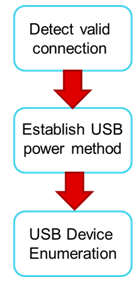ZHCSH16C November 2017 – August 2019 TPS25820 , TPS25821
PRODUCTION DATA.
- 1 特性
- 2 应用
- 3 说明
- 4 修订历史记录
- 5 Pin Configuration and Functions
- 6 Specifications
- 7 Detailed Description
-
8 Application and Implementation
- 8.1 Application Information
- 8.2 Typical Applications
- 9 Power Supply Recommendations
- 10Layout
- 11器件和文档支持
- 12机械、封装和可订购信息
7.1.2 Configuration Channel
The function of the configuration channel is to detect connections and configure the interface across the USB Type-C cables and connectors.
Functionally the Configuration Channel (CC) is used to serve the following purposes:
- Detect connect to the USB ports
- Resolve cable orientation and twist connections to establish USB data bus routing
- Establish Source and Sink roles between two connected ports
- Discover and configure power: USB Type-C current modes or USB Power Delivery
- Discovery and configure optional Alternate and Accessory modes
- Enhances flexibility and ease of use
Typical flow of DFP to UFP configuration is shown in Figure 8:
 Figure 8. DFP to UFP Connect Flow
Figure 8. DFP to UFP Connect Flow